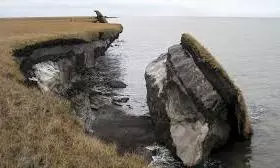
Thawing permafrost drives greenhouse gas emissions, accelerating climate change
text_fieldsNew research underscores the growing impact of thawing permafrost on global warming, revealing that vast amounts of stored greenhouse gases are being released from the Arctic as temperatures rise.
A study co-authored by NASA and led by Stockholm University highlights how this thawing permafrost, which has stored carbon for thousands of years, is transforming the Arctic from a carbon sink into a significant source of emissions.
Permafrost is permanently frozen ground that preserves layers of organic material such as dead plants and animals. With increasing temperatures, this frozen ground begins to thaw, allowing microbes to break down the organic matter and release greenhouse gases like carbon dioxide and methane into the atmosphere. This process initiates a worrying feedback loop, where released gases contribute to warming, accelerating further permafrost thaw and emissions.
The study analyzed greenhouse gas emissions across the Arctic between 2000 and 2020. Initially, Arctic ecosystems, especially forests, acted as carbon sinks by absorbing more carbon dioxide than they released. However, over time, emissions from Arctic lakes, rivers, and wildfires offset this balance, transforming the region into a net source of emissions.
Methane, a greenhouse gas significantly more effective at trapping heat than carbon dioxide, emerged as a major contributor to the region’s emissions, particularly from wetlands and lakes. Although methane has a shorter lifespan in the atmosphere than carbon dioxide, its immediate warming effect makes it especially concerning.
The research team combined “bottom-up” and “top-down” approaches for measuring emissions. Bottom-up methods involved ground-level measurements and predictive models, while top-down techniques relied on satellite observations of atmospheric gas concentrations. While each approach yielded slightly different results, they collectively revealed the scale and complexity of Arctic emissions.
As thawing permafrost shifts greenhouse gas dynamics, the global warming threat grows more severe. The findings emphasize the need for proactive climate policies to mitigate the risks associated with these emissions.























